Your donation will support the student journalists of North Cobb High School. Your contribution will allow us to purchase equipment and cover our annual website hosting costs.
From Claire’s to crop tops: Preteen girls maturing at quicker rates
May 12, 2016
A mother coming home with the infamous Discovering My Body American Girl book may possibly serve as the most uncomfortable, repulsive moment in any young 10-13 year old girl’s life. However, the decision that this girl makes about learning about puberty and taking her mother’s advice versus searching the internet for answers and listening to her uneducated and ill-informed friends will make the difference between what MD Medical Author for Medicinenet.com Melissa Conrad Stoppler explains as a positive or negative “process effect on the psychosocial and emotional development of the adolescent.”
The rapid advancements in technology, including social and mass media, harmfully affect early developing young girls’ health, behavior, and self-image.
The dreaded “P word,” puberty, takes over the easily manipulated mind and body of the young girl. Stöppler explains, “Puberty is the period during which growing boys or girls undergo the process of sexual maturation.” These physical stages or steps lead eventually to fertility and physical changes for males and females during adolescence.
Today, many adolescent girls reach puberty significantly earlier than ever previously recorded.

Girls are beginning puberty younger and younger, resulting in behavior changes.
According to Joel Fuhrman, M.D and writer for Disease Proof in the early 1900s, most girls begin menstruation at approximately 15 years of age. Several decades later, more began at age 12, and today the start of menses frequently occurs anywhere from 8 to 10 years old. Doctors believe that the drastic changes in nutrition and environmental influences have caused the change. Writers for WebMD state, “A number of studies have shown an association between obesity in young girls and an increased risk of precocious puberty. However, researchers don’t know how direct the link is. Obesity does not seem to be connected to early puberty in boys.”
Mayo Clinic writers believe, “There’s usually no identifiable cause for this type of precocious puberty.”

Social media, like mass media, turns girls to a more materialistic life style. People create profiles on Twitter and Instagram that in no way reflect an honest picture of themselves. Social media claims to connect people with friends, but these so called friends and followers, if they even exist, might live three states away and own nothing but a username. Often social media users would rather appear to have a fully lived life than actually live one. Hewitt explains, “The best time to post photos is around 9, you get more likes that way.” Photos of fancy coffee and straight faced girls, spiral the virtual world in attempts to gain the most followers and likes as possible.
Obesity and environmental factors may induce precocious puberty and affect the physical aspects of development, but the influence of today’s social and mass media control the psychological growth of a young girl’s mind. The pressures of living up to the unrealistic images of models seen on social media greatly impact the self confidence and body expectations of adolescent girls . In 2004, Dove began the Dove Campaign for Real Beauty with a mission to inspire young women to find the beauty in themselves. Dove encourages mothers to present the realities of beauty perception, sexuality, and body image to their daughters. The company has also created self-esteem- building, educational programs and activities that encourage, inspire and motivate girls around the world. After their initial launch in 2004, Dove successfully reached out to over 15 million girls by 2015.
As the adolescent girl struggles with her self-image, she resorts to dangerous methods to achieve an impossible look. Many girls will starve themselves in an attempt to look like the computer-enhanced pictures of models in the media.
“The Internet and social media have brought us amazing things. The downside, specifically related to the clients—with Facebook and Instagram, in particular—is it floods us with images that are very often unrealistic,” said Dr. Constance Quinn, New York site director of the Renfrew Center, an institute for the treatment of eating disorders in women.
Social media, where users exchange information and photos and communities form over common interests, has become a bastion for some struggling with eating disorders. Images of spindly legs, concave stomachs and jutting ribs emerge on various sites by searching hashtags like #thinspogram #thighgap or #bonespo. These disturbing photos often accompany even more shocking “thinspirational” messages—”Pretty girls don’t eat,” “Skip dinner, be thinner” and “You have to exercise for a week to work off the thigh fat from a single Snickers.”
Many psychologists say that the mind controls the body, especially in times of stress, which puberty brings on with a determined force. Girls seldom turn to their parents for advice on how to deal with their stress. Instead, they look to their friends and social media to deal with the pains of puberty.
These avenues of information cause distorted thoughts of how they should look and act in order to feel accepted. Popular egotistical artists such as Kanye West, Rihanna and Nikki Manaj fabricate public personas that young girls see as strong and confident. Female artists and fashion icons, prance around in tiny skin tight clothes attempting to flaunt everything that they have.
https://open.spotify.com/user/averyrenee07/playlist/51DpKeQS0chgA5fhpGfxN8
Rapper Kanye West states during an interview, “My biggest pain in life is that I will never be able to see myself perform live.” This arrogant “I only care about me” mentality appears to have rubbed off on more than half of this generation.

Famous people, like Kanye West and Kylie Jenner, provide less-than-ideal role models for kids going through puberty.
Awtrey Middle School 8th grader Jessie Skribba explains, “My biggest role model is Wiz Khalifa. He is very successful and doesn’t care what anyone thinks.”
Music and TV cause children and teenagers to shift their eyes to a more glamorous lifestyle, provocative clothes, and bad attitudes. The young girl’s quest for perfection will naturally cause frustration and stress upon not being able to immediately emulate these stars. The impressionable young girl imitates these idols, which causes her to act more like an out of control older teenager rather than a 10-year-old child.
This idolization of celebrities grows steadily. In 2010, middle schoolers walked the halls in bedazzled American Eagle t-shirts and bell bottom jeans. Now crop tops and cut off jean shorts adorn the bodies of adolescent girls.
The onset of social media’s influence undoubtedly has also changed how these youths interact, receive attention, and view themselves as maturing and wanted young ladies.
Awtrey Middle School 8th grader Maddie Hewitt accurately sums the overwhelming issue: “I think I like Instagram the best. It is a way to let the world know you exist. If you can’t be famous for a talent, maybe you can through your selfies.”
